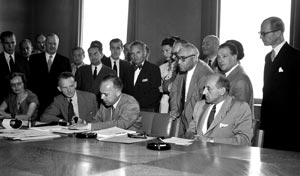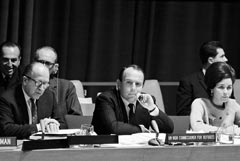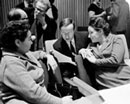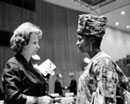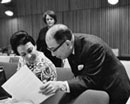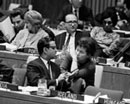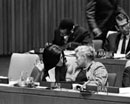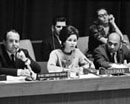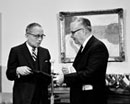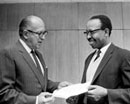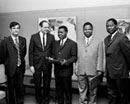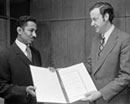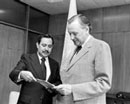|
Convention relating to the Status of Refugees
Geneva, 28 July 1951 Protocol relating to the Status of Refugees New York, 31 January 1967
By Guy S. Goodwin-Gill
Senior Research Fellow, All Souls College, Oxford
Introduction
The 1951 Convention relating to the Status of Refugees, with just one “amending” and updating Protocol adopted in 1967 (on which, see further below), is the central feature in today’s international regime of refugee protection, and some 144 States (out of a total United Nations membership of 192) have now ratified either one or both of these instruments (as of August 2008). The Convention, which entered into force in 1954, is by far the most widely ratified refugee treaty, and remains central also to the protection activities of the United Nations High Commissioner for Refugees (UNHCR). In the aftermath of the Second World War, refugees and displaced persons were high on the international agenda. At its first session in 1946, the United Nations General Assembly recognized not only the urgency of the problem, but also the cardinal principle that “no refugees or displaced persons who have finally and definitely ... expressed valid objections to returning to their countries of origin ... shall be compelled to return ...” (resolution 8 (I) of 12 February 1946). The United Nations’ first post-war response was a specialized agency, the International Refugee Organization (IRO, 1946-1952), but notwithstanding its success in providing protection and assistance and facilitating solutions, it was expensive and also caught up in the politics of the Cold War. It was therefore decided to replace it with a temporary, initially non-operational agency, and to complement the new institution with revised treaty provisions on the status of refugees. The historical context also helps to explain both the nature of the Convention and some of its apparent limitations. Just six years before its conclusion, the Charter of the United Nations had identified the principles of sovereignty, independence, and non-interference within the reserved domain of domestic jurisdiction as fundamental to the success of the Organization (Article 2 of the Charter of the United Nations). In December 1948, the General Assembly adopted the Universal Declaration of Human Rights, article 14, paragraph 1, of which recognizes that, “Everyone has the right to seek and to enjoy in other countries asylum from persecution”, but the individual was only then beginning to be seen as the beneficiary of human rights in international law. These factors are important to an understanding of both the manner in which the 1951 Convention is drafted (that is, initially and primarily as an agreement between States as to how they will treat refugees), and the essentially reactive nature of the international regime of refugee protection (that is, the system is triggered by a cross-border movement, so that neither prevention, nor the protection of internally displaced persons come within its range). After extensive discussions in its Third Committee, the General Assembly moved to replace the IRO with a subsidiary organ (under Article 22 of the Charter of the United Nations), and by resolution 428 (V) of 14 December 1950, it decided to set up the Office of the United Nations High Commissioner for Refugees with effect from 1 January 1951. Initially set up for three years, the High Commissioner’s mandate was regularly renewed thereafter for five-year periods until 2003, when the General Assembly decided “to continue the Office until the refugee problem is solved” (resolution 58/153 of 22 December 2003, paragraph 9). The High Commissioner’s primary responsibility, set out in paragraph 1 of the Statute annexed to resolution 428 (V), is to provide “international protection” to refugees and, by assisting Governments, to seek “permanent solutions for the problem of refugees”. Its protection functions specifically include “promoting the conclusion and ratification of international conventions for the protection of refugees, supervising their application and proposing amendments thereto” (paragraph 8 (a) of the Statute). A year earlier, in 1949, the United Nations Economic and Social Council appointed an Ad Hoc Committee to “consider the desirability of preparing a revised and consolidated convention relating to the international status of refugees and stateless persons and, if they consider such a course desirable, draft the text of such a convention”. The Ad Hoc Committee decided to focus on the refugee (stateless persons were eventually included in a second convention, the 1954 Convention relating to the Status of Stateless Persons), and duly produced a draft convention. Its provisional draft drew on IRO practice under its Constitution, identified a number of categories of refugees, such as the victims of the Nazi or Falangist regimes and those recognized under previous international agreements, and also adopted the general criteria of well-founded fear of persecution and lack of protection (See United Nations doc. E/AC.32/L.6, 23 January 1950).
The Conference met in Geneva from 2 to 25 July 1951 and took as its basis for discussion the draft which had been prepared by the Ad Hoc Committee on Refugees and Stateless Persons, save that the Preamble was that adopted by the Economic and Social Council, while article 1 (definition) was as recommended by the General Assembly and annexed to resolution 429 (V). On adopting the final text, the Conference also unanimously adopted a Final Act, including five recommendations covering travel documents, family unity, non-governmental organizations, asylum, and application of the Convention beyond its contractual scope. Notwithstanding the intended complementarity between the responsibilities of the UNHCR and the scope of the new Convention, a marked difference already existed: the mandate of the UNHCR was universal and general, unconstrained by geographical or temporal limitations, while the definition forwarded to the Conference by the General Assembly, reflecting the reluctance of States to sign a “blank cheque” for unknown numbers of future refugees, was restricted to those who became refugees by reason of events occurring before 1 January 1951 (and the Conference was to add a further option, allowing States to limit their obligations to refugees resulting from events occurring in Europe before the critical date). Article 1A, paragraph 1, of the 1951 Convention applies the term “refugee”, first, to any person considered a refugee under earlier international arrangements. Article 1A, paragraph 2, read now together with the 1967 Protocol and without the time limit, then offers a general definition of the refugee as including any person who is outside their country of origin and unable or unwilling to return there or to avail themselves of its protection, on account of a well-founded fear of persecution for reasons of race, religion, nationality, membership of a particular group, or political opinion. Stateless persons may also be refugees in this sense, where country of origin (citizenship) is understood as “country of former habitual residence”. Those who possess more than one nationality will only be considered as refugees within the Convention if such other nationality or nationalities are ineffective (that is, do not provide protection). The refugee must be “outside” his or her country of origin, and the fact of having fled, of having crossed an international frontier, is an intrinsic part of the quality of refugee, understood in its ordinary sense. However, it is not necessary to have fled by reason of fear of persecution, or even actually to have been persecuted. The fear of persecution looks to the future, and can also emerge during an individual’s absence from their home country, for example, as a result of intervening political change. Although the risk of persecution is central to the refugee definition, “persecution” itself is not defined in the 1951 Convention. Articles 31 and 33 refer to those whose life or freedom “was” or “would be” threatened, so clearly it includes the threat of death, or the threat of torture, or cruel, inhuman or degrading treatment or punishment. A comprehensive analysis today will require the general notion to be related to developments within the broad field of human rights (cf. 1984 Convention against Torture, article 7; 1966 International Covenant on Civil and Political Rights, article 3; 1950 European Convention on Human Rights, article 6; 1969 American Convention on Human Rights, article 5; 1981 African Charter of Human and Peoples’ Rights). At the same time, fear of persecution and lack of protection are themselves interrelated elements. The persecuted clearly do not enjoy the protection of their country of origin, while evidence of the lack of protection on either the internal or external level may create a presumption as to the likelihood of persecution and to the well-foundedness of any fear. However, there is no necessary linkage between persecution and Government authority. A Convention refugee, by definition, must be unable or unwilling to avail him- or herself of the protection of the State or Government, and the notion of inability to secure the protection of the State is broad enough to include a situation where the authorities cannot or will not provide protection, for example, against the persecution of non-State actors. The Convention requires that the persecution feared be for reasons of “race, religion, nationality, membership of a particular social group (added at the 1951 Conference), or political opinion”. This language, which recalls the language of non-discrimination in the Universal Declaration of Human Rights and subsequent human rights instruments, gives an insight into the characteristics of individuals and groups which are considered relevant to refugee protection. Persecution for the stated reasons implies a violation of human rights of particular gravity; it may be the result of cumulative events or systemic mistreatment, but equally it could comprise a single act of torture. Persecution under the Convention is thus a complex of reasons, interests, and measures. The measures affect or are directed against groups or individuals for reasons of race, religion, nationality, membership of a particular social group, or political opinion. These reasons in turn show that the groups or individuals are identified by reference to a classification which ought to be irrelevant to the enjoyment of fundamental human rights. The Convention does not just say who is a refugee, however. It goes further and sets out when refugee status comes to an end (article 1C; for example, in the case of voluntary return, acquisition of a new, effective nationality, or change of circumstances in the country of origin). For particular, political reasons, the Convention also puts Palestinian refugees outside its scope (at least while they continue to receive protection or assistance from other United Nations agencies (article 1D)), and excludes persons who are treated as nationals in their State of refuge (article 1E). Finally, the Convention definition categorically excludes from the benefits of refugee status anyone whom there are serious reasons to believe has committed a war crime, a serious non-political offence prior to admission, or acts contrary to the purposes and principles of the United Nations (article 1F). From the very beginning, therefore, the 1951 Convention has contained clauses sufficient to ensure that the serious criminal and the terrorist do not benefit from international protection. Besides identifying the essential characteristics of the refugee, States party to the Convention also accept a number of specific obligations which are crucial to achieving the goal of protection, and thereafter an appropriate solution. Foremost among these is the principle of non-refoulement. As set out in the Convention, this prescribes broadly that no refugee should be returned in any manner whatsoever to any country where he or she would be at risk of persecution (see also article 3, 1984 Convention against Torture, which extends the same protection where there are substantial grounds for believing that a person to be returned would be in danger of being tortured). The word non-refoulement derives from the French refouler, which means to drive back or to repel. The idea that a State ought not to return persons to other States in certain circumstances is first referred to in article 3 of the 1933 Convention relating to the International Status of Refugees, under which the contracting parties undertook not to remove resident refugees or keep them from their territory, “by application of police measures, such as expulsions or non-admittance at the frontier (refoulement)”, unless dictated by national security or public order. Each State undertook, “in any case not to refuse entry to refugees at the frontiers of their countries of origin”. The 1933 Convention was not widely ratified, but a new era began with the General Assembly’s 1946 endorsement of the principle that refugees with valid objections should not be compelled to return to their country of origin (see above, resolution 8 (I)). The Ad Hoc Committee on Statelessness and Related Problems initially proposed an absolute prohibition on refoulement, with no exceptions (United Nations Economic and Social Council, Summary Record of the twentieth meeting, Ad Hoc Committee on Statelessness and Related Problems, First Session, United Nations doc. E/AC.32/SR.20, (1950), 11-12, paras. 54 to 55). The 1951 Conference of Plenipotentiaries qualified the principle, however, by adding a paragraph to deny the benefit of non-refoulement to the refugee whom there are “reasonable grounds for regarding as a danger to the security of the country..., or who, having been convicted by a final judgment of a particularly serious crime, constitutes a danger to the community of that country.” Apart from such limited situations of exception, however, the drafters of the 1951 Convention made it clear that refugees should not be returned, either to their country of origin or to other countries in which they would be at risk. In addition to the core protection of non-refoulement, the 1951 Convention prescribes freedom from penalties for illegal entry (article 31), and freedom from expulsion, save on the most serious grounds (article 32). Article 8 seeks to exempt refugees from the application of exceptional measures which might otherwise affect them by reason only of their nationality, while article 9 preserves the right of States to take “provisional measures” on the grounds of national security against a particular person, but only “pending a determination by the Contracting State that that person is in fact a refugee and that the continuance of such measures is necessary ... in the interests of national security”. States have also agreed to provide certain facilities to refugees, including administrative assistance (article 25); identity papers (article 27), and travel documents (article 28); the grant of permission to transfer assets (article 30); and the facilitation of naturalization (article 34). Given the further objective of a solution (assimilation or integration), the Convention concept of refugee status thus offers a point of departure in considering the appropriate standard of treatment of refugees within the territory of Contracting States. It is at this point, where the Convention focuses on matters such as social security, rationing, access to employment and the liberal professions, that it betrays its essentially European origin; it is here, in the articles dealing with social and economic rights, that one still finds the greatest number of reservations, particularly among developing States. The Convention proposes, as a minimum standard, that refugees should receive at least the treatment which is accorded to aliens generally. Most-favoured-nation treatment is called for in respect of the right of association (article 15), and the right to engage in wage-earning employment (article 17, paragraph 1). The latter is of major importance to the refugee in search of an effective solution, but it is also the provision which has attracted most reservations. Many States have emphasized that the reference to most-favoured-nation shall not be interpreted as entitling refugees to the benefit of special or regional customs, or economic or political agreements. Other States have expressly rejected most-favoured-nation treatment, limiting their obligation to accord only that standard applicable to aliens generally, while some view article 17 merely as a recommendation, or agree to apply it “so far as the law allows”. “National treatment”, that is, treatment no different from that accorded to citizens, is to be granted in respect of a wide variety of matters, including the freedom to practice religion and as regards the religious education of children (article 4); the protection of artistic rights and industrial property (article 14); access to courts, legal assistance, and exemption from the requirement to give security for costs in court proceedings (article 16); rationing (article 20); elementary education (article 22, paragraph 1); public relief (article 23); labour legislation and social security (article 24, paragraph 1); and fiscal charges (article 29). Article 26 of the Convention prescribes such freedom of movement for refugees as is accorded to aliens generally in the same circumstances. Eleven States have made reservations, eight of which expressly retain the right to designate places of residence, either generally, or on grounds of national security, public order (ordre public) or the public interest. While reservations are generally permitted under both the Convention and the Protocol, the integrity of certain articles is absolutely protected, including articles 1 (definition); 3 (non-discrimination); 4 (religion); 16, paragraph 1 (access to courts); and 33 (non-refoulement). Under the Convention, reservations are further prohibited with respect to articles 36 to 46, which include a provision entitling any party to a dispute to refer the matter to the International Court of Justice (article 38). The corresponding provision of the 1967 Protocol (article IV) may be the subject of reservation, and some have been made; to date (August 2008), however, no State has sought to make use of the dispute settlement procedure. The General Assembly identified a protection role for the High Commissioner in relation, in particular, to international agreements on refugees. States party to the 1951 Convention/1967 Protocol have accepted specific obligations in this regard, agreeing to cooperate with the Office and in particular to “facilitate its duty of supervising the application of the provisions” of the Convention and Protocol (article 35 of the Convention; article II of the Protocol). Treaty oversight mechanisms, such as those established under the 1966 International Covenant on Civil and Political Rights, the 1984 United Nations Convention against Torture and the 1989 Convention on the Rights of the Child, have distinct roles, which may include both the review of national reports and the determination of individual or inter-State complaints. UNHCR does not possess these functions, and the precise nature of the obligation of States is not always clear, although together with the statutory role entrusted to UNHCR by the General Assembly, it is enough to give the Office a sufficient legal interest (locus standi) in relation to States’ implementation of their obligations under the Convention and Protocol. States generally do not appear to accept that UNHCR has the authority to lay down binding interpretations of these instruments, but it is arguable that the position of the UNHCR generally on the law or specifically on particular refugee problems requires to be considered in good faith. In practice, States commonly associate UNHCR with their refugee decision-making, and UNHCR provides regular guidance on issues of interpretation. Its Handbook on Procedures and Criteria for Determining Refugee Status, published in 1979 at the request of States members of the UNHCR Executive Committee, is regularly relied on as authoritative, if not binding, and more recent guidelines are also increasingly cited in refugee determination procedures. The origins of the 1967 Protocol relating to the Status of Refugees, which reflected recognition by UNHCR and the States members of its Executive Committee that there was a disjuncture between the universal, unlimited UNHCR Statute and the scope of the 1951 Convention, were quite different from those of the latter. Instead of an international conference under the auspices of the United Nations, the issues were addressed at a colloquium of some thirteen legal experts which met in Bellagio, Italy, from 21 to 28 April 1965. The Colloquium did not favour a complete revision of the 1951 Convention, but opted instead for a Protocol by way of which States parties would agree to apply the relevant provisions of the Convention, but without necessarily becoming party to that treaty. The approach was approved by the UNHCR Executive Committee and the draft Protocol was referred to the Economic and Social Council for transmission to the General Assembly. The General Assembly took note of the Protocol (the General Assembly commonly “takes note” of, rather than adopts or approves, instruments drafted outside the United Nations system), and requested the Secretary-General to transmit the text to States with a view to enabling them to accede (resolution 2198 (XXI) of 16 December 1966). The Protocol required just six ratifications and it duly entered into force on 4 October 1967. The Protocol is often referred to as “amending” the 1951 Convention, but in fact, and as noted above, it does no such thing. The Protocol is an independent instrument, not a revision within the meaning of article 45 of the Convention. States parties to the Protocol, which can be ratified or acceded to by a State without becoming a party to the Convention, simply agree to apply articles 2 to 34 of the Convention to refugees defined in article 1 thereof, as if the dateline were omitted (article I of the Protocol). As of August 2008, Cape Verde, Swaziland, the United States of America and Venezuela have acceded only to the Protocol, while Madagascar, Monaco, Namibia and St. Vincent & the Grenadines are party only to the Convention (and the Congo, Madagascar, Monaco, and Turkey have retained the geographical limitation). Article II on the cooperation of national authorities with the United Nations is equivalent to article 35 of the Convention, while the few remaining articles (just eleven in all) add no substantive obligations to the Convention regime. The Convention is sometimes portrayed today as a relic of the cold war and as inadequate in the face of “new” refugees from ethnic violence and gender-based persecution. It is also said to be insensitive to security concerns, particularly terrorism and organized crime, and even redundant, given the protection now due in principle to everyone under international human rights law. The Convention does not deal with the question of admission, and neither does it oblige a State of refuge to accord asylum as such, or provide for the sharing of responsibilities (for example, by prescribing which State should deal with a claim to refugee status). The Convention also does not address the question of “causes” of flight, or make provision for prevention; its scope does not include internally displaced persons, and it is not concerned with the better management of international migration. At the regional level, and notwithstanding the 1967 Protocol, refugee movements have necessitated more focused responses, such as the 1969 OAU/AU Convention on the Specific Aspects of Refugee Problems in Africa and the 1984 Cartagena Declaration; while in Europe, the development of protection doctrine under the 1950 European Convention on Human Rights has led to the adoption of provisions on “subsidiary” or “complementary” protection within the legal system of the European Union. Nevertheless, within the context of the international refugee regime, which brings together States, UNHCR and other international organizations, the UNHCR Executive Committee, and non-governmental organizations, among others, the Convention continues to play an important part in the protection of refugees, in the promotion and provision of solutions for refugees, in ensuring the security of States, sharing responsibility, and generally promoting human rights. A Ministerial Meeting of States Parties, convened in Geneva in December 2001 by the Government of Switzerland to mark the fiftieth anniversary of the Convention, expressly acknowledged, “the continuing relevance and resilience of this international regime of rights and principles...”. In many States, judicial and administrative procedures for the determination of refugee status have established the necessary legal link between refugee status and protection, contributed to a broader and deeper understanding of key elements in the Convention refugee definition, and helped to consolidate the fundamental principle of non-refoulement. While initially concluded as an agreement between States on the treatment of refugees, the 1951 Convention has inspired both doctrine and practice in which the language of refugee rights is entirely appropriate. It was no failure in 1951 not to have known precisely how the world would evolve; on the contrary, it may be counted a success that the drafters of the 1951 Convention were in fact able to identify, in the concept of a well-founded fear of persecution, the enduring, indeed universal, characteristics of the refugee, and to single out the essential, though never exclusive, reason for flight. That certainly has not changed, even if the scope and extent of the refugee definition have matured under the influence of human rights, and even as there is now increasing recognition of the need to enhance and ensure the protection of individuals still within their own country. This Introductory Note was written in August 2008.
Related Materials
Convention relating to the Status of Refugees By resolution 248 B (IX) of 8 August 1949, the Economic and Social Council established the Ad Hoc Committee on Statelessness and Related Problems to consider the desirability of preparing a revised and consolidated convention relating to the international status of refugees and stateless persons and consider means of eliminating the problem. The Ad Hoc Committee, consisting of representatives of thirteen Governments, met from 16 January to 16 February 1950 and adopted a report containing the text of a draft Convention relating to the Status of Refugees and a Protocol thereto relating to the Status of Stateless Persons, with commentaries (E/1618 (E/AC.32/5) and Corr. 1). By a note of 10 March 1950, the Secretary-General transmitted the report of the Ad Hoc Committee to Governments and invited their comments thereon, in order that these, together with the report, could be submitted to the eleventh session of the Economic and Social Council. (These comments are contained in documents E/1703 and Add. 1 to 7, and E/1704 and Corr.1 and 2.) The report of the Ad Hoc Committee and the comments received thereon were considered by the Social Committee of the Economic and Social Council from 31 July to 3 August and from 5 to 10 August 1950, and by the Council on 2 and 11 August 1950 (E/SR.399 and A/SR.406-407). The Social Committee discussed in detail the definition of the term “refugee” in the draft Convention, and considered and amended the draft Preamble. The draft definition and Preamble, as amended, were adopted by the Economic and Social Council on 11 August 1950. On the same date, the Council adopted resolution 319 B (XI), in which it took note of the report of the Ad Hoc Committee, of the draft agreements contained therein and of the comments received from Governments. It requested that the Secretary-General reconvene the Ad Hoc Committee to prepare revised drafts of the two instruments, taking into account the comments of Governments and of specialized agencies, and of discussions and decisions of the Economic and Social Council at its eleventh session, including the definition of the term “refugee” and the Preamble as approved by the Council.
On 14 December 1950, the General Assembly, considering the report of the Third Committee, adopted resolution 429 (V), by which it decided to convene a conference of plenipotentiaries in Geneva to complete the drafting of the Convention relating to the Status of Refugees and the Protocol relating to the Status of Stateless Persons. The Assembly further recommended that the Governments participating in the conference take into consideration the draft Convention submitted by the Economic and Social Council and, in particular, the text of the definition of the term “refugees”, as contained in an annex to resolution 429 (V), which had been further amended by the Assembly prior to adopting the resolution (A/PV.325). The United Nations Conference of Plenipotentiaries on the Status of Refugees and Stateless Persons met from 2 to 25 July 1951 and, on 25 July 1951, adopted the Convention relating to the Status of Refugees (A/CONF.2/108/Rev.1). The Convention entered into force on 22 April 1954, in accordance with its article 43, following the deposit of the sixth instrument of ratification. Protocol relating to the Status of Refugees In his annual report to the General Assembly at its twentieth session, in 1965, the High Commissioner for Refugees referred to a Colloquium on Legal Aspects of Refugee Problems, organized by the Carnegie Endowment for International Peace, during which the limitation of the personal scope of the Convention on the Status of Refugees had been discussed, including possible measures whereby the Convention might be extended to cover new refugee situations (A/6011/Rev.1, paras. 33 and 34). In 1966, the High Commissioner referred again to the question of a possible extension of the scope of the Convention (A/6311/Rev.1, para. 40) and, following consultations with States parties to the Convention and with members of the Executive Committee of the High Commissioner’s Programme, submitted the text of a draft Protocol relating to the Status of Refugees, removing the date limitation in the Convention and thereby extending its scope, to the Executive Committee at its sixteenth session (A/AC.96/346). The Executive Committee took note of the draft Protocol and made certain modifications to the text. On the Committee’s recommendation, the High Commissioner submitted the draft Protocol, as modified, to the General Assembly of the United Nations, through the Economic and Social Council, as an addendum to his annual report (A/6311/Rev.1/Add.1). The Economic and Social Council, in its resolution 1186 (XLI) of 18 November 1966, took note with approval of the draft Protocol (A/6303/Add.1) and transmitted the High Commissioner’s report to the General Assembly, which referred it to its Third (Social, Humanitarian and Cultural) Committee for consideration. The Third Committee considered the draft Protocol, under the agenda entitled “Report of the United Nations High Commissioner for Refugees”, from 5 to 7 December 1966. On 7 December 1966, it adopted a draft resolution providing for approval of the Protocol (A/6586, draft resolution II). The General Assembly considered the corresponding report of the Third Committee on 16 December 1966 and, by its resolution 2198 (XXI) of the same date, took note of the Protocol and requested the Secretary-General to transmit the text of the Protocol to the States mentioned in article V thereof, with a view to enabling them to accede to it (A/PV.1495). The authentic text of the Protocol was signed by the President of the General Assembly and the Secretary-General in New York on 31 January 1967, and transmitted to Governments. The Protocol entered into force on 4 October 1967, in accordance with its article VIII, on the day of deposit of the sixth instrument of accession.
Selected preparatory documents Convention relating to the Status of Refugees
Economic and Social Council resolution 248 B (IX) of 8 August 1949 (Study of Statelessness) Protocol relating to the Status of Refugees Report of the United Nations High Commissioner for Refugees to the General Assembly 1964/1965 (Official Records of the General Assembly, Twentieth Session, Supplement No. 11 (A/6011/Rev.1)) The Convention relating to the Status of Refugees entered into force on 22 April 1954. For the current participation status of the Convention, as well as information and relevant texts of related treaty actions, such as reservations, declarations, objections, denunciations and notifications, see: The Protocol relating to the Status of Refugees entered into force on 4 October 1967. For the current participation status of the Protocol, as well as information and relevant texts of related treaty actions, such as reservations, declarations, objections, denunciations and notifications, see:
|
||||||||||||||||||||||||||||||||||||||||||||||||||||||||||||||||||||||||||||||||||||||||||||||||||||||||

